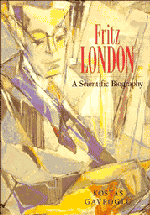Book contents
- Frontmatter
- Contents
- Preface
- Acknowledgements
- 1 From philosophy to physics
- 2 The years in Berlin and the beginnings of quantum chemistry
- 3 Oxford and superconductivity
- 4 Paris and superfluidity
- 5 Tying up loose ends: London in the USA
- Afterword: background leading to the microscopic theory of superconductivity by John Bardeen
- Publications by Fritz London
- Bibliography
- Index
2 - The years in Berlin and the beginnings of quantum chemistry
Published online by Cambridge University Press: 12 January 2010
- Frontmatter
- Contents
- Preface
- Acknowledgements
- 1 From philosophy to physics
- 2 The years in Berlin and the beginnings of quantum chemistry
- 3 Oxford and superconductivity
- 4 Paris and superfluidity
- 5 Tying up loose ends: London in the USA
- Afterword: background leading to the microscopic theory of superconductivity by John Bardeen
- Publications by Fritz London
- Bibliography
- Index
Summary
Fritz London went to Berlin at the start of the winter semester of 1927–1928 and left for Oxford at the end of August 1933. He was Schrödinger's assistant and became a Privatdozent in 1928. During this time he was away for a month in Leningrad and for six months in Rome. In the joint paper with Walter Heitler, written when both were at Zürich in 1927, it was shown that the formation of the hydrogen molecule was a purely quantum mechanical phenomenon, whose understanding depended on the Pauli exclusion principle. In his Berlin years, London exploited fully the possibilities provided by the notion of a purely quantum phenomenon, and developed the rather abstruse group theoretical method to deal with polyelectronic molecules and with the difficulties of calculations involving many bodies. He also developed a theory of chemical reactions as activation processes. In 1930, together with Eisenschitz, he started to investigate the characteristics of the molecular forces. He found out that they could be understood only as manifestations of the uncertainty principle – another purely quantum mechanical notion. In Berlin, he was in an intellectually stimulating environment and was highly appreciated by all the holy men there: Einstein, von Laue, Schrödinger and the retired Planck. He signed a contract with Springer to write a book about atomic and molecular forces. He met Edith Caspary and they were married in 1929. He placed his younger brother Heinz in good hands; but after a short stay with Gerlach in Berlin, Heinz went to Breslau to work with Franz Simon.
- Type
- Chapter
- Information
- Fritz LondonA Scientific Biography, pp. 38 - 95Publisher: Cambridge University PressPrint publication year: 1995



